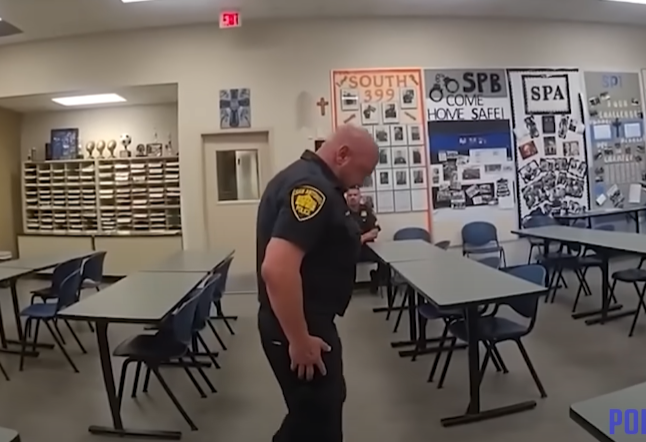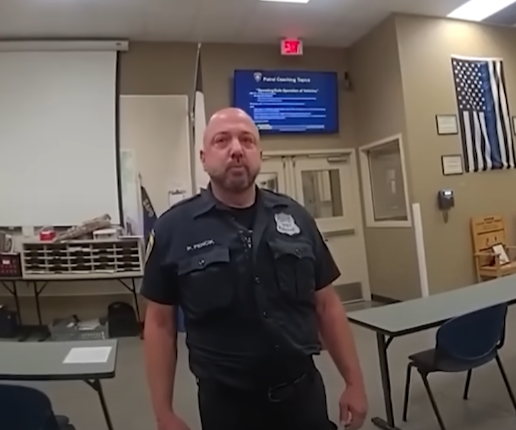In a rare and unsettling incident that has drawn attention from both the public and law enforcement professionals, an officer identified as Paul was arrested by his own colleagues after being suspected of driving while intoxicated (DWI). The arrest took place not on a roadside, but inside a police station — a setting that underscored the seriousness and unusual nature of the case.
The chain of events began when Paul, visibly uneasy, was approached by members of the DWI unit under the authority of the chief’s office. Officer Allison, assigned to handle the evaluation, explained that his duty was to determine whether Paul had been operating a vehicle under the influence.
Although Paul initially denied driving — claiming he was only in a parking lot — investigators noted there was video evidence showing him behind the wheel, a point that contradicted his repeated insistence. From the start, the exchange between Paul and the officers set the tone for what became a highly tense and revealing confrontation.
Reading of Rights and Initial Reactions
Following established legal procedure, Officer Allison began by reading Paul his Miranda rights: the right to remain silent, the right to an attorney, and the warning that anything said could be used in court.
Paul acknowledged these rights but appeared conflicted and defensive. At one point, he asked whether refusing a test would result in jail time. The officers maintained that the choice was his, but hinted that refusal would not be without consequence.
“What am I going to do? I’ve got no choice,” Paul muttered, signaling resignation as the process unfolded.
The Sobriety Tests
The standardized field sobriety tests, designed to assess physical coordination, balance, and cognitive focus, became the central part of the encounter. Paul was asked to perform multiple tasks that challenged both his motor skills and his mental clarity:
- Horizontal Gaze Nystagmus (HGN) Test – Following the tip of a pen with his eyes while keeping his head still.
- Walk-and-Turn Test – Walking nine heel-to-toe steps along an imaginary straight line, turning carefully, and returning in the same manner while counting aloud.
- One-Leg Stand Test – Raising one foot six inches off the ground and maintaining balance while counting.
- Head Tilt and Time Estimation – Tilting his head back, closing his eyes, and estimating the passage of 30 seconds.
- Finger-to-Nose Test – Touching his nose with the tip of his finger upon verbal command, alternating between left and right hands.
- Alphabet Sequence Test – Reciting the alphabet from the letter “C” through “P” without singing the traditional song.
- Counting Backwards – Counting from 54 down to 41 without mistakes or pauses.
Though Paul attempted to comply, observers noted that his performance raised serious concerns of impairment. He occasionally staggered, appeared confused about instructions, and once struggled to correctly recite the sequence of numbers.

Emotional Tension and References to Victims
In the midst of the evaluation, a separate and emotional detail surfaced. Officers mentioned two young girls who had reportedly witnessed aspects of the incident, clarifying that Paul had not harmed them but acknowledging the trauma they might endure from what they had seen.
The inclusion of this detail shifted the tone, reminding everyone present of the real human cost of impaired driving. Even if no one was physically injured, the psychological impact on bystanders — especially children — was profound.
The Shock of Turning Inward
One of the most striking aspects of this case is that Paul’s arrest was carried out by his own fellow officers. Traditionally, law enforcement presents a united front. Yet in this instance, accountability demanded an internal reckoning.
Officer Allison emphasized that the decision was not about supervision or hierarchy but about personal responsibility. “This isn’t a supervisory issue. This is about you. Nobody wants to be here, but here we are,” he told Paul firmly.
For many, the symbolism is powerful: law enforcement officers, bound by duty, arresting one of their own in the very halls of justice. It sends a message that no badge provides immunity from the law.

Broader Implications for the Force
The incident has sparked conversations beyond the immediate case. Experts point out that law enforcement officers face high levels of stress, exposure to trauma, and mental health challenges. When these pressures intersect with substance use, the consequences can be severe — for officers themselves, their colleagues, and the communities they serve.
Public trust is another key concern. The community may view the arrest as a betrayal of duty, yet at the same time, it demonstrates the system’s willingness to enforce the law impartially. By treating Paul as any other suspect, the department reinforced its commitment to transparency and accountability.
What Comes Next?
Paul was ultimately taken into custody following the completion of sobriety testing. As of now, details remain unclear about whether he will face formal charges, suspension, or termination. Department officials have confirmed that an internal investigation is ongoing.
The arrest has already become a subject of discussion among legal experts, civil rights advocates, and community members. Some see it as a cautionary tale, while others view it as a moment of accountability that could strengthen public trust.
Conclusion
This case is more than a single arrest — it is a moment of reckoning for law enforcement. An officer, sworn to uphold the law, was reminded in the most personal way that he too must abide by it.
The story of Paul’s arrest inside a police station is both sobering and symbolic: a reminder that justice does not discriminate, even when the accused wears a uniform.


